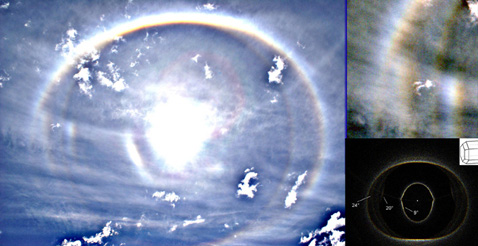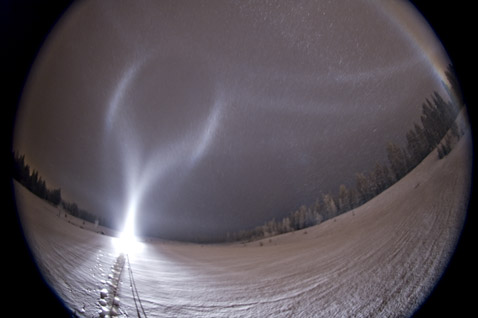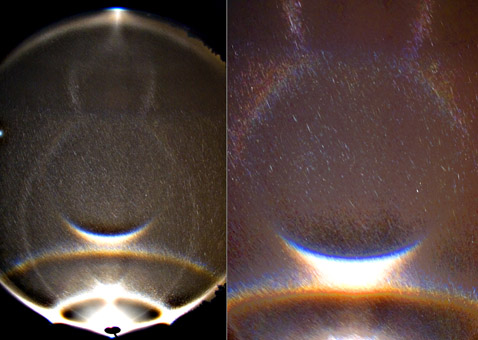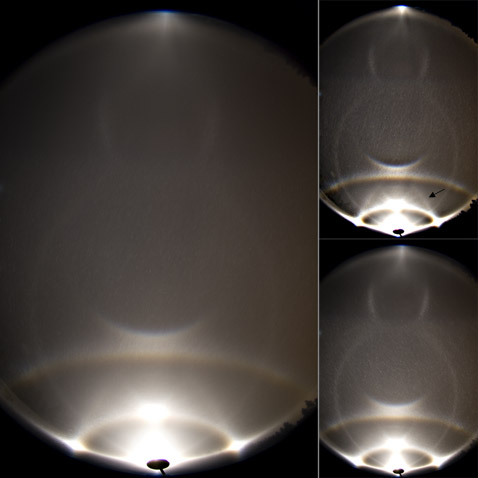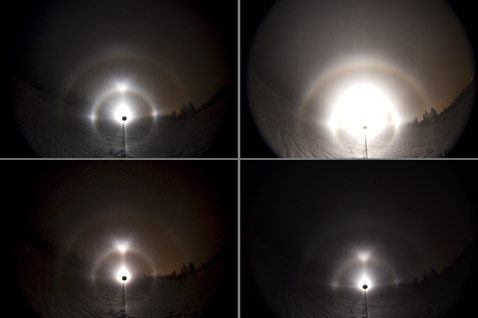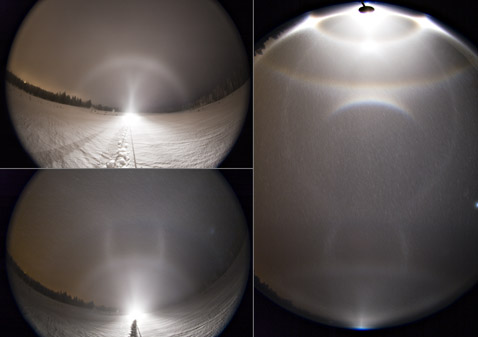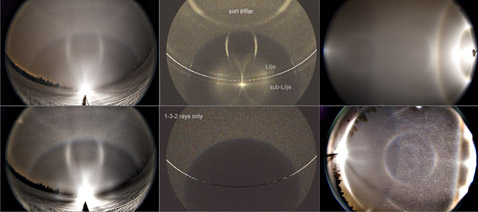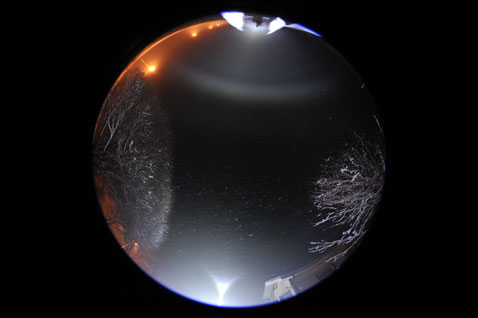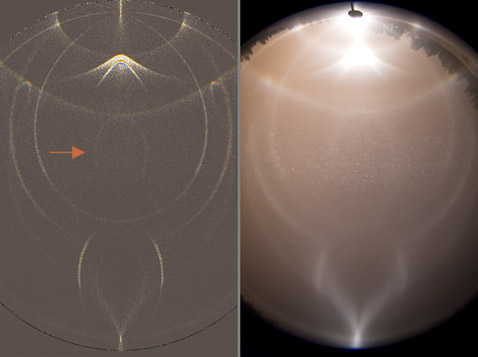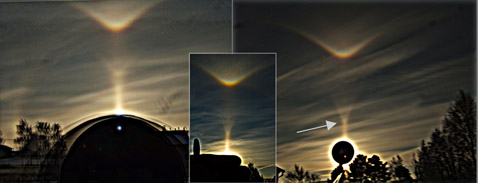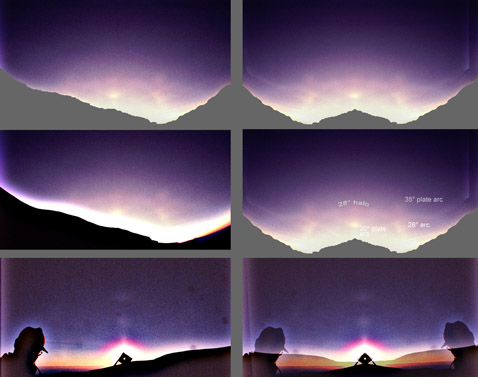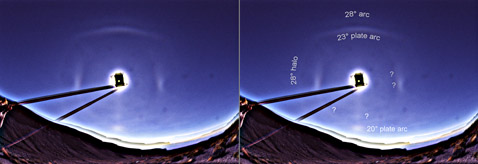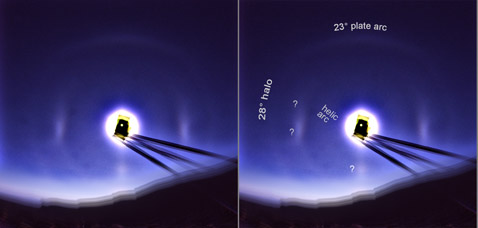2008. december 28., vasárnap
Odd radius column arc display
This display with 24°, 20° and 9° column arcs was observed at 10:47 on 29 June 2008 near Tselinograd by Konstantin Bespalov.
The original photos can be found here: ( 1 - 2 ), and a simulation of this display by Marko Riikonen here: ( 3 ).
2008. december 26., péntek
Effects of crystal swarm density variation in halos
These photos and animation ( 1 ) show rather prominent effects in halos from crystal swarm density variation. Photos are from 7/8 December display in Rovaniemi.
2008. december 25., csütörtök
Reflected Lowitz arcs with crystals

2008. december 24., szerda
Another photo of 7/8 December in Rovaniemi
In this photo of 7/8 December in Rovaniemi there is nothing that we haven't seen before. But ordinary lamp halos are quite well developed, like the subanthelic arc that loops all the way to subanthelic point.
Merry Christmas to all.
Merry Christmas to all.
2008. december 23., kedd
Kern arc on 7/8 December in Rovaniemi
While sub-Kern was strong in the 7/8 December display, the Kern arc was less so. For one thing, I did not see it visually. In the two photos showing it, it can hardly be distinguished from the overlapping heliac arc. The other one of these photos is shown here. On the right is a heavily enhanced version zoomed at the zenith region.
2008. december 21., vasárnap
Reflected Lowitz arcs in 7/8 December display
Two consecutive photos of the 7/8 December display contain reflected Lowitz arcs. The large image above is a stack of these two photos, the small upper image being heavily unsharp masked version of it. Reflected Lowitz arc is marked with an arrow in the small image.
The moment of reflected Lowitz arcs was short lasting: two photos showing them were taken within 35 seconds. Photos taken immediately before or after do not contain them. The lower small photo is timed one minute before their appearance, the halo composition being otherwise similar except for the reflected Lowitz arcs.
In these photos present is also upper sunvex Parry arc, which was missing from the display phase shown in my previous postings.
The moment of reflected Lowitz arcs was short lasting: two photos showing them were taken within 35 seconds. Photos taken immediately before or after do not contain them. The lower small photo is timed one minute before their appearance, the halo composition being otherwise similar except for the reflected Lowitz arcs.
In these photos present is also upper sunvex Parry arc, which was missing from the display phase shown in my previous postings.
Lampside of 7/8 December
Here are photos taken towards the lamp. They were taken at the time when blue circle was strong on the opposite side of the sky. The upper ones are single images, exposure times 2 and 15 seconds. The lower images are stacked from a couple of frames with 1 to 2 seconds exposures.
Simulations say the lamp elevation is pretty close to 5 degrees. Images show upper sunvex Parry but no suncave Parry. Low lamp elevation may alone exclude suncave Parry, but as it is seen in some other photos, changes in crystal prism face ratios must be responsible for this difference. Best simulations of these photos are obtained with Parry crystals that are towards a triangular shape.
Simulations say the lamp elevation is pretty close to 5 degrees. Images show upper sunvex Parry but no suncave Parry. Low lamp elevation may alone exclude suncave Parry, but as it is seen in some other photos, changes in crystal prism face ratios must be responsible for this difference. Best simulations of these photos are obtained with Parry crystals that are towards a triangular shape.
2008. december 19., péntek
Another Bouguer's halo
These three single photos are from different stages of the 7/8 December display in Rovaniemi. They all show Bouguer's halo, i.e. fogbow together with halos. But in reality halos and fogbow were seen mainly separately, in swiftly passing ice and water clouds. 30 seconds exposure has captured them nicely in the same frame.
2008. december 15., hétfő
Circular subanthelic halo from 3-5-6-7-(2)-3 raypath
The subhorizon photos of 7/8 December show what seems to be part of a diffuse circular halo surrounding the subanthelic point. Similar effect can be simulated with random oriented crystals (arrow in the simulation on the left). It arises from raypaths 3-5-6-7-3 and 3-5-6-7-2-3, which in plate crystals make respectively the Liljequist and sub-Liljequist parhelia.
The simulation on the right provides a 180 degree view of halos from random orientation centered around the subanthelic point. The bright dot is the subanthelion. The narrow small radius halo is from raypath that I have not checked. It seems to disappear if the crystals deviate even a little from regular hexagonal shape. Then there is the diffuse 3-5-6-7-(2)-3 subanthelic halo and blue circle.
Finally, a note on the Parry crystals used in the simulation on the left: no triangles this time, regular h/d 1 hexagons were used. Simulations with Jukka Ruoskanen's software.
The simulation on the right provides a 180 degree view of halos from random orientation centered around the subanthelic point. The bright dot is the subanthelion. The narrow small radius halo is from raypath that I have not checked. It seems to disappear if the crystals deviate even a little from regular hexagonal shape. Then there is the diffuse 3-5-6-7-(2)-3 subanthelic halo and blue circle.
Finally, a note on the Parry crystals used in the simulation on the left: no triangles this time, regular h/d 1 hexagons were used. Simulations with Jukka Ruoskanen's software.
Blue circle
What happens when tilts of the crystals that make blue spot increase? The blue spot starts to elongate vertically, forming eventually a blue circle. It is shown in these images that were taken on 7/8 December night in Rovaniemi.
Simulations in the middle used plate crystal tilts of 90 degrees to make blue circle. In the lower simulation the 1-3-2 rays responsible for blue circle are shown (probably also 3-1-6 rays contributed, but they were not included).
Blue circle is a circle of about 70 degrees radius around the subanthelic point. The intersection of parhelic circle and blue circle is the location of the blue spot. This gives us a practical insight on why blue spot changes position and elongates with increasing sun elevation ( 1 ).
Also other halos are seen in the photos. Some of these are named in the simulations, which are made with Jukka Ruoskanen's software.
Simulations in the middle used plate crystal tilts of 90 degrees to make blue circle. In the lower simulation the 1-3-2 rays responsible for blue circle are shown (probably also 3-1-6 rays contributed, but they were not included).
Blue circle is a circle of about 70 degrees radius around the subanthelic point. The intersection of parhelic circle and blue circle is the location of the blue spot. This gives us a practical insight on why blue spot changes position and elongates with increasing sun elevation ( 1 ).
Also other halos are seen in the photos. Some of these are named in the simulations, which are made with Jukka Ruoskanen's software.
2008. december 12., péntek
Bouguer's halo
On the 5th December in Nivala water fog lay still in the air at -7 C temperature. So conditions were perfect for testing the halo gun which sprays water-kaoline mixture to initiate ice nucleation ( 1 ). The spray was carried to nearby field where it started rapid transformation of fog into diamond dust. In the beginning a fogbow was present at the same time with halos ( 2 ) but as ice nucleation proceeded, only column crystal halo display was seen in the spotlight beam ( 3 ).
A couple of old observations depict an apparent fogbow observed simultaneously with halos. In such a situations it has been called as Bouguer's halo. The observation from which the name originates, however, is without halos. It was made in Peruvian Andes in 1735 by explorers Pierre Bouguer and Antonio de Ulloa. The drawing made by Ulloa features also glory ( 4 ).
Seeing Bouguer's halo, i.e. fogbow together with halos, is not easy, because ice crystals and fog droplets tend not to occur together in suitable mixture. And even if the mixture is right, fog may be too thick for sun or moon to shine through. In that situation a bright spotlight gives an advantage.
A couple of old observations depict an apparent fogbow observed simultaneously with halos. In such a situations it has been called as Bouguer's halo. The observation from which the name originates, however, is without halos. It was made in Peruvian Andes in 1735 by explorers Pierre Bouguer and Antonio de Ulloa. The drawing made by Ulloa features also glory ( 4 ).
Seeing Bouguer's halo, i.e. fogbow together with halos, is not easy, because ice crystals and fog droplets tend not to occur together in suitable mixture. And even if the mixture is right, fog may be too thick for sun or moon to shine through. In that situation a bright spotlight gives an advantage.
2008. december 11., csütörtök
A halo from Parry oriented crystals with raypath 4-8-1
The photo is from last weekends major display. The arrow in the accompanying simulation (Jukka Ruoskanen's program) points to a halo that arises from Parry crystals with raypath 4-8-1 (where 3 is upper face). This arc was found from photos previous winter ( 1 ). Simulations showed then that triangular Parry crystals made it. Same applies to this new case: Parry halos in the display were simulated successfully only with triangular crystals.
2008. december 9., kedd
Subhorizon plate crystal halos
On the night of 7/8 December in Rovaniemi water fog was nucleated to diamond dust by snow machines, and a major display was observed in a spotlight beam for several hours. The photo above is from the end stage when plates dominated.
The lamp is downhill below the horizon (about 11.5 degrees), which shifts subhorizon halos above the horizon. Halos are named in the simulation which is made with Jukka Ruoskanen's program. Sub-Kern and sub-120° parhelia have not been documented before. By other means these are difficult to see. One needs to sit in an airplane which happens to pass through a high quality crystal cloud and sub-Kern is also located so low that one probably is not able be view it from small airplane window.
Crystals used in the simulation were plates which prism faces were allowed to variate freely in size within some limits. This produced the rather uniform stretch of subparhelic circle where sub-Liljequist parhelia are becoming hard to distinguish. Had there been solely regular hexagons in the air, the sub-Liljequist parhelia would have been better defined.
There was also circumnadir arc, which is another new feature. Les Cowley ( 1 ) has more on this and other subhorizon halos in the display.
The lamp is downhill below the horizon (about 11.5 degrees), which shifts subhorizon halos above the horizon. Halos are named in the simulation which is made with Jukka Ruoskanen's program. Sub-Kern and sub-120° parhelia have not been documented before. By other means these are difficult to see. One needs to sit in an airplane which happens to pass through a high quality crystal cloud and sub-Kern is also located so low that one probably is not able be view it from small airplane window.
Crystals used in the simulation were plates which prism faces were allowed to variate freely in size within some limits. This produced the rather uniform stretch of subparhelic circle where sub-Liljequist parhelia are becoming hard to distinguish. Had there been solely regular hexagons in the air, the sub-Liljequist parhelia would have been better defined.
There was also circumnadir arc, which is another new feature. Les Cowley ( 1 ) has more on this and other subhorizon halos in the display.
2008. december 6., szombat
Reflected lower sunvex Parry behaviour
To supplement Les's posting, here is the behaviour of the reflected Parry as a function of sun elevation. At sun elevations higher than about 11 degrees, the halo arc is below the sun. The halo is perhaps easiest understood by thinking of it as a Parry arc of the subsun. At the solar elevations given in these simulations, it stays all the time at 22 degrees above the subsun. So if you know solar elevation, you know also where it is located relative to the sun.
In simulations for 15 and 20 degrees sun elevation also the normal lower sunvex Parry is seen, being as much below the horizon as the reflected Parry is above the horizon. Simulations are made with Jukka Ruoskanen's software.
In simulations for 15 and 20 degrees sun elevation also the normal lower sunvex Parry is seen, being as much below the horizon as the reflected Parry is above the horizon. Simulations are made with Jukka Ruoskanen's software.
2008. december 5., péntek
A peculiar halo on 6 November in Rovaniemi
In the image on the left is Moilanen arc among other halos. On the right is similar looking halo (arrow), but its V is more pointed and it is also closer to the sun, about 7 degrees above it. These are stacked images, the inset image is a single frame showing the same arc (and also a weak Moilanen arc above it).
This halo seems to be what could be called a "reflected lower sunvex Parry arc". It was Walt Tape who suggested this kind of explanation for the arc. I will later add a post with simulations, crystal figures and raypaths. Pictures of the halo were published today in Tähdet ja avaruus magazine in Finland.
*** addition 5 December: see the upcoming posting on Les Cowley's site ( 1 ), which lights up the formation of this arc ***
This halo seems to be what could be called a "reflected lower sunvex Parry arc". It was Walt Tape who suggested this kind of explanation for the arc. I will later add a post with simulations, crystal figures and raypaths. Pictures of the halo were published today in Tähdet ja avaruus magazine in Finland.
*** addition 5 December: see the upcoming posting on Les Cowley's site ( 1 ), which lights up the formation of this arc ***
2008. december 4., csütörtök
Lascar display V
For the very lowest sun elevations there are only two photos, both shown here. Four uppermost images are versions of the same photo, which was the last one taken that day. Because halos have turned reddish, I suspect the sun was already below horizon.
Again a new feature has appeared, the 35° plate arcs. Others are familiar from previous postings.
To avoid wash-out from unsharp masking, ground was removed. For comparison, in the image on the middle left, the ground has not been removed. Same amount of unsharp mask and levels has been applied to both versions.
Photos at the bottom are from 1.6 degrees sun elevation (not to scale with upper photos). Two arcs directly above the sun are 20° upper plate arc and "Moilanen arc". From this slide the latter was measured to be 12 degrees from the sun.
Again a new feature has appeared, the 35° plate arcs. Others are familiar from previous postings.
To avoid wash-out from unsharp masking, ground was removed. For comparison, in the image on the middle left, the ground has not been removed. Same amount of unsharp mask and levels has been applied to both versions.
Photos at the bottom are from 1.6 degrees sun elevation (not to scale with upper photos). Two arcs directly above the sun are 20° upper plate arc and "Moilanen arc". From this slide the latter was measured to be 12 degrees from the sun.
2008. december 3., szerda
Lascar display IV
Now the sun elevation at Lascar is 2-3 degrees. The image is four frame stack. 20° upper plate arc is well visible. New feature, "Moilanen arc", has appeared. We observed it visually, it was V-shaped, not like the light mass seen in this photo. Photographing this arc was difficult, because it appeared and disappeared in seconds intervals. Measurements from two slides placed the arc at 10.5° from the sun, which is less than for Moilanen arc. But of course there is uncertainty in that value.
Lascar display III
Continuing the Lascar halos tour. This image gives situation for sun elevation range of 11° to 9°. Image is stacked from four photos and also mirrored version is provided. 23° plate arc is already disappearing high up above the sun, but 20° upper plate arc on the other hand is appearing.
10 years ago we simulated the display with octahedral crystals of cubic ice and traditional pydamidal crystals. Octahedral crystal gives halos only at 28° and 19° from the sun. It was a good candidate for simulating because many features in photos from different solar elevations fell in place with it.
Among other things these simulations predicted that the 20° upper plate arc would be actually composed of two arcs, the other one being 19° upper arc... But there are still too many unexplained features in the display to trust our model, one being the fake 18° plate arcs.
2008. december 2., kedd
Lascar display II
Another phase of the Lascar display. Three photos are stacked from sun elevation range of about 32° to 30°. Familiar halos are 23° and 20° plate arcs. Other halos are not so familiar.
2008. december 1., hétfő
Lascar display
This was seen on 27 November 1997 in Chile, on the foot of Lascar volcano, where Leena Virta and I photographed it. The image - that is stacked from nine slides - presents only one stage of the display. The photos were taken in 10 minutes interval, during which sun elevation change was from 25.5° to 23.5°.
The display contained some exotic halos, such as 28° halo. There seem to be also traditional pyramidal crystal halos, in this image 23° plate arc and pyramidal helic arc. However, what looks as 18° plate arcs are actually below the level of the sun (this was pointed out by Walt Tape years ago).
The display contained some exotic halos, such as 28° halo. There seem to be also traditional pyramidal crystal halos, in this image 23° plate arc and pyramidal helic arc. However, what looks as 18° plate arcs are actually below the level of the sun (this was pointed out by Walt Tape years ago).
Feliratkozás:
Bejegyzések (Atom)
